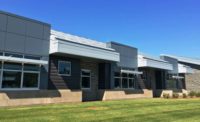Forensics Lab Gets “New Life” with Insulation

One might think the Kentucky State Police’s Central Forensics Lab in Frankfort would be feeling some heat. They’d recently achieved fame as the first state in the nation to use the new ANDE Rapid DNA system to help speed up work on sexual assault cases and clear the backlog. However, they weren’t feeling much heat at all because the old state building was poorly insulated, so it was losing heat and allowing in moisture.
Heat loss, moisture issues, and leaky windows made the lab, built in 1951 and expanded in 1969-70, a challenging place to work and administer. The building needed remediation, but the busy state police crime lab couldn’t afford to close, so their architects sought a flexible, after-hours solution.
“We had to work at night,” says Manual Adler, president of Purefoam Roofing and Insulation, Shelbyville, Ky., the company selected to correct the problems. “Usually we spend a few days prepping and then do the job, but because this was such a large project, about 40,000 square-feet, and we could only work at night, we spent five full nights prepping, then clean it all up before we left, and had to re-prep each evening when we got there.”
According to Adler the building’s problem was a lack of insulation. “There was virtually no insulation on the exterior concrete walls or the roof deck, so heat and air were escaping like a sieve. That was causing uncomfortable conditions, higher energy costs, and moisture on the walls that bled through the drywall.”
Purefoam chose closed-cell spray polyurethane foam (SPF) insulation called InsulBloc by U.S. company NCFI Polyurethanes, to better seal the building envelope. Adler says, “We tore out the drywall to get to the concrete and spray-applied three inches of InsulBloc. We then put up 40-feet of scaffolding in the center span of the lobby area and spray-applied three inches of InsulBloc to the roof deck and a thermal and ignition barrier fire protection over the foam once it cured.”
He adds, “Because it’s a scientific forensics lab we had to be careful to cover and tape everything to keep the dust and overspray away. We’d be in there working at 1-2am when they’d bring in a body in a bag to the morgue, then have to work around it. All I can say is it was downright eerie. We didn’t do a lot of talking, just working to get it done to perfection and get out of there.”
“When we finished, it was tight. Our blower tests showed InsulBloc provided significantly better air and moisture barriers. It will last the life of the building, provide amazing insulating value to help save them big on energy costs, and it can help improve indoor air quality by keeping out moisture that could trigger mold growth. You could say, cadavers and all, we gave a new life to that place.”
Looking for a reprint of this article?
From high-res PDFs to custom plaques, order your copy today!




.jpg?height=200&t=1645633720&width=200)


